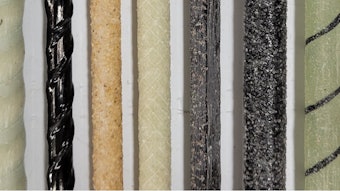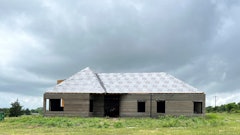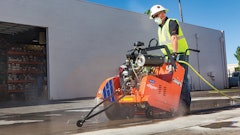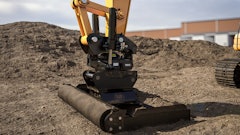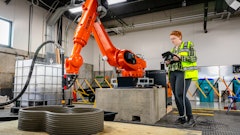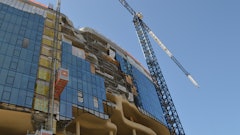
After years of planning, the construction of the Theodore Roosevelt Presidential Library began in the summer of 2023. Concrete contractor Winn Construction is at the helm using a low-carbon concrete mix to help the building achieve its goal of setting new standards for sustainability. The library is targeted to open July 4, 2026 - the country’s 250th birthday. Concrete Contractor caught up with the contractor and ready-mix supplier early May 2024 to find out how the work is going and their experience with the low-carbon mix.
The concrete used for the Theodore Roosevelt Presidential Library (TRPL) project is a new low-carbon mix designed to reduce the global warming potential by nearly 50%, compared to standard mixes from the ready-mix supplier, utilizing recycled byproducts such as fly ash and slag. Meant to be a model of self-sufficiency being carbon-neutral, the building was designed to minimize its footprint in both construction as well as environmental. Native plants and seeds were collected along with thousands of yards of soil to be planted on the library’s roof and surrounding areas.  Photo by Snøhetta Plomp
Photo by Snøhetta Plomp
Ben Olin, CQTM, assistant ready mix division manager and technical services director of ready-mix concrete supplier Dickinson Ready Mix – sees the library as a generational project for both the company and region as the area doesn’t get that many projects of this magnitude often. “To be able to say that I had a significant role in it – you get the guys in the back talking about it. They love going out there. They love being a part of it. Our team takes a lot of pride in it.”
 Photo by Chad Ziemendorf
Photo by Chad Ziemendorf
He adds, “It’s a privilege. I’m glad to be working on it myself and most of the people here feel the same way.”
The construction of the Theodore Roosevelt Presidential Library (TRPL) broke ground in July 2023 in the small city of Medora, North Dakota – estimated population 131 (as of 2024). In his online “Message From the CEO,” Edward O’Keefe, Chief Executive Officer for the library foundation, explains why North Dakota was chosen. The story goes that Teddy first came to the area in September 1883 to hunt. Months later, his wife and mother die on the same day. After completing his third term as a New York assemblyman, he returned to the area to mourn and recover. The area and its people must have left quite the impression on him. President Roosevelt was later quoted, “I never would have been President if it has not been for my experiences in North Dakota.” The rest is history.
Medora, North Dakota is also home to the Theodore Roosevelt National Park South Unit. With the history, the location is a fitting home for the new library.
Willie Winn started Winn Construction in 1981 with a single pickup and started on smaller residential and commercial projects. Despite down years, they grew each year – expanding and hiring. “I feel we have a very good group of very hard-working men that really care about what they do and the product that they put out,” says Winn, owner and president of Winn Construction. “I think that’s what separates us from the rest. We have a no quit attitude; a lot of our people are that way,” he says.
 Photo by Chad Ziemendorf
Photo by Chad Ziemendorf
Additional features of the TRPL include an auditorium wall designed to be 24-ft. high above grade which will be 12-in. thick around three sides; a stairwell wall, another retaining wall on the other end; and standard footings for the interior foundation.
Familiar with the Doka gang-forming system, Winn contacted a supplier in Bismark, North Dakota for the taller wall sections – but a majority of the project was completed with an Symons forming system.
“A lot of the roof transfer is through the roof into the auditorium walls and then into the structural steel with just pads and piers,” adds Darnell Douglas, vice president of Winn Construction. The company owns their own Putzmeister 47RZ-Meter concrete pump. Rented aerial lifts have also been key for the project with the height of the walls.
 Photo by Chad Ziemendorf
Photo by Chad Ziemendorf
Working a Low-Carbon Mix
Working with the low-carbon mix, Winn says that the low-carbon mix hasn’t affected the construction. According to test results, the concrete was coming back the same or higher than their regular six bag mix they were more familiar with. The mix also included a strength enhancer additive.
Dickinson Ready-Mix contracted Dr. Kevin McDonald, Julie Buffenbarger, and the team at Beton Consulting Engineers LLC out of Minneapolis in the development of the low-carbon mix to meet the sustainability requirements. When they initially started, explains Douglas, one of the problems they had was having such a high replacement factor extending the time that the concrete took for it to reach strength. After working the mix, the low-carbon concrete is able to reach 28-day spec 4,000 psi while reaching 3,500 to 4,000 at seven. “Some of the [concrete] at 28 days, they were getting close to 6,500,” says Douglas. Specifications were performance-based.
 Photo by Chad Ziemendorf
Photo by Chad Ziemendorf
 Photo by Chad Ziemendorf
Photo by Chad Ziemendorf
- Class F fly ash
- Grade 100 slag
- 50-70% replacement rate of SCMs
Winn saw an average of a 4.7% increase costs for the low-carbon mixes:
- Footing: 3.1%
- Retaining wall: 3.7%
- Interior slab on grade: 3.8%
- Shearwall/MD 1: 3.5%
- Shearwall/MD 2: 5.2%
- Exterior concrete 1: 5.9%
- Exterior concrete 2: 7.8%
While the mixes are working, both the Winn and Dickinson Ready Mix teams were aware of the potential issues regarding low-carbon mixes, like potentially needing 56 or 90 days to reach strength. Luckily, this wasn’t the case. “This is definitely a unique mix,” he says. “From my understanding, these mixes are outperforming any expectations. We’re hitting strengths at 28 days,” adds Olin.
 Photo by Chad Ziemendorf
Photo by Chad Ziemendorf
Because they’ll have a finish to them, Winn and Dickinson conducted a 40 by 40 test panel for the exterior slab mixes. Winn poured and finished it to have a better idea on what to expect and address any concerns.
“For mixes like these, where it’s unique for both the supplier and contractor, it’s essential to have that communication and let them get their hands on so they know what to expect and what’s going to happen in the field,” suggests Olin.
“As people get used to working with it, they’ll adapt to figure out what they need to do,” says Winn. And that’s exactly what happened. Though they were nervous and hesitant with the change from normal, Douglas says that everyone was comfortable with it and happy with they way the concrete was turning out.
“The walls actually look great,” he says. “The finish on the surface is nice. Not a lot of air holes. Our people did a good job because you don’t see pour lines. You don’t see honeycombs and things like that in the surface – they turned out very nice. I don’t think we would have an issue with taking something like this on again.”
The Theodore Roosevelt Presidential Library is expected to open its doors and let all visitors appreciate the brand-new low-carbon concrete on July 4, 2026.
 RenderingPhoto by Snøhetta Plomp
RenderingPhoto by Snøhetta Plomp RenderingPhoto by Snøhetta Plomp
RenderingPhoto by Snøhetta Plomp

